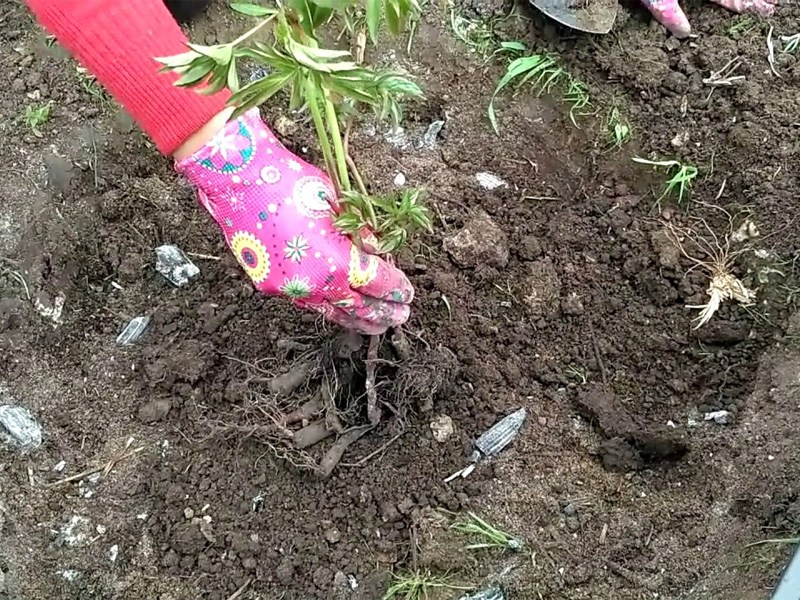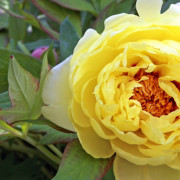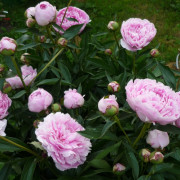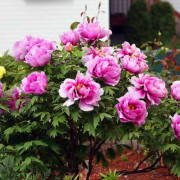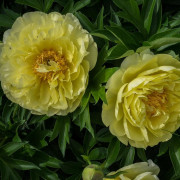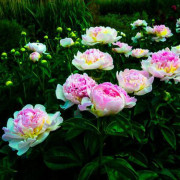Milk-flowered peony (Paeonia Lactiflora) - features of cultivation
Content:
- Milk-flowered peony (Paeonia Lactiflora) - what kind of peonies it is, the history of creation
- Classification of the species of lactic-flowered peonies
- The varieties that are in the greatest demand among gardeners
- Growing a flower, how to plant it in open ground
- Milk-flowered varieties care
- Blooming lactic-flowered peonies
- Peonies after flowering
- Diseases, pests and ways to control them
Peony is one of the most popular flowers to be grown in the garden. A separate interesting category is the milk-flowered peony.
Milk-flowered peony (Paeonia Lactiflora) - what kind of peonies it is, the history of creation
Before buying seeds, you need to study all the characteristics of the plant. The maximum plant height is 1 meter. The older the plant, the larger the flowers.
Brief description, characteristic
Many flower growers are interested in the question: milk-flowered peonies - what kind of plants are these? Milk-flowered peony (lat.paeonia lactiflora) refers to herbaceous perennials. The foliage is lush, dark green in color. Flowers are ordinary and double.
Advantages and disadvantages of the view
Benefits:
- beautiful and abundant flowering;
- unpretentious care;
- can grow in one place for a long time, does not need frequent transplants;
- variety of varieties.
Use in landscape design
Milky peony is often used in landscape design. The plant looks harmoniously in single and group plantings. It is also used to decorate borders.
Classification of the species of lactic-flowered peonies
The plant is subdivided into several types.
Medicinal
Perennial herb. The height of the stems is 50-80 cm. The flowers are simple, usually dark red in color.
Evading
The wild-growing variety is better known as Maryin root.
Narrow-leaved
The peculiarity of this species is that the leaves are very thin, like spruce needles. The flowers are simple, maroon in color.
Tree-like
The variety is distinguished by thick, erect stems and lush foliage.
Mlokosevich
Leaves of a dark green hue. Stems are erect. The flowers are ordinary, wide open.
The varieties that are in the greatest demand among gardeners
The best varieties of milk-flowered peony, which are in great demand among flower growers.
the charm
The charm variety is distinguished by several shades of inflorescence. The flowers are white, light pink and pink.
Francois Ortegat
The flowers are large, up to 17 cm in diameter. The inflorescences are terry, maroon shade.
Paul M. Wild
The diameter of the flowers is up to 20 cm. The inflorescences are terry, crimson.
Sword Dance
The type of the flower is ordinary, the petals are cherry-colored. In the center with yellow staminodes.
Yellow
Yellow has a lemon shade of petals. Terry inflorescence.
Red
Red variety is distinguished by raspberry-cherry color of inflorescences.
Carl Rosenfield
The Carl Rosenfield variety is distinguished by its large flowers, up to 15 cm in diameter. The petals are fuchsia.
Nippon Beauty
The flowers are simple, the petals are burgundy. In the center are yellow staminodes.
Big Ben
Inflorescences of a rich red-carmine shade.
Others
Among other varieties, Sorbet is popular with an unusual shape of flowers of a pink-milky hue. Another variety of White Wings with white simple buds. Bowl of Beauty is a plant with delicate pink petals.
Growing a flower, how to plant it in open ground
Features of growing a peony at home.
Planting by root cuttings
A root cutting is a small piece of rhizome with a bud and a small root. Features of growing plants with root cuttings:
- Dig out the rhizome, clean it from the ground, cut off the decayed areas.
- Divide it into several pieces, so that each has a growth bud and a root. Cuttings should be 2-4 cm each.
- Soak them for several hours in a weak solution of potassium permanganate for disinfection.
- Then dry and roll in crushed charcoal.
- Leave the cuttings overnight so that a thin crust appears in the places of the cuts.
- Plant the cuttings in the beds at a distance of 30-40 cm from each other.
What time is the boarding
The best period for cuttings is July-August. Plants grown from cuttings are best replanted in autumn (until mid-October).
Location selection
The peony prefers to grow in sunny areas, sheltered from cold winds. It is not recommended to plant a plant in the shade. Flowering will be poor.
How to prepare the soil and flower for planting
Loamy soil is optimal for peony. A few months before planting, the soil is dug up and rotted manure is introduced. Then repeat the procedure again just before planting.
Planting procedure step by step
Planting a peony in the ground:
- dig a hole;
- expanded clay is poured at the bottom of the hole;
- place the seedling in the ground and sprinkle it;
- the root collar cannot be buried, the flower will take root for a long time.
At the end of planting, water the seedling abundantly with warm water. If several bushes grow nearby, the distance between them is at least 30 cm.
Seed planting
Growing a peony by seed is a laborious task. It is not always possible to achieve a positive result. Description of planting by seeds:
- seeds are harvested from August to September;
- immediately after collection, the planting material is planted in open ground to a depth of 5 cm;
- on the eve of winter, the place where the seeds are planted is mulched with peat or sawdust;
- before the onset of cold weather, the mulch is covered with a layer of lapotnik.
Some sprouts appear in the spring the following year.
Milk-flowered varieties care
Milk-flowered peony is unpretentious in care.
Watering and feeding
The bushes begin to water in the spring, in late April and early May. Enough 2-3 waterings per week. In summer, plants are watered every day if it is hot.
From dressings, you can use complex mineral fertilizers. In early spring, ammonium nitrate is added to the soil. During the flowering period, peonies are fed with potassium and phosphorus. You can use a solution of ammonium nitrate (6 g), superphosphate (10 g) and potassium salt (5 g).
Mulching and loosening
Several times a month, before watering, the soil must be loosened and all weeds pulled out. Mulching peonies is optional, especially in regions with mild winters.
Preventive treatment
As a prophylaxis against pests and diseases, the bushes are sprayed with Iskra or Karbofos before pruning. From folk methods, treatment with a yarrow solution helps.
Blooming lactic-flowered peonies
During the flowering period, peonies need special care so that they are abundant.
A period of activity and rest
The flowering period lasts from late May to mid June. The dormant period occurs in August-March.
Care during and after flowering
Several buds are usually formed on the stems. But when they bloom, the flowers are small. In order for the inflorescences to be large on each stem, only one upper bud is left, the lateral ones are cut off. Faded peonies are immediately cut off.
After flowering, you need to immediately collect the fallen petals. Because of them, fungal diseases can appear. Many growers stop watering the bushes after flowering, but this cannot be done. To lay the buds, the bush needs moisture.
What to do if it does not bloom, possible reasons
Reasons why the peony does not bloom:
- the root collar is set too deep;
- the plant is in the shade;
- the peony was not transplanted for a long time;
- too frequent transplantation of the bush.
Peonies after flowering
Features of plant care after flowering.
Transfer
The plant does not need frequent transplants. In one place, it can grow up to 10-15 years. It is necessary to transplant if the flower began to grow poorly or stopped blooming.
It is not advisable to perform the procedure immediately after flowering. During transplantation, the plant is carefully dug out so as not to damage the roots and planted in a new place.
Pruning
Once the buds have bloomed, they can be cut off. The foliage can be left until autumn.
Preparing for winter
Peonies are frost-resistant plants; they do not need shelter for the winter. In northern latitudes, you can mulch the soil near the bush for prevention.
Diseases, pests and ways to control them
Most often, peonies infect fungi. The most common diseases:
- rust;
- gray rot;
- powdery mildew;
- verticillary wilting.
From pests can be found ants, aphids, rootworm nematode, bronze. For the fight, fungicides and insecticides are used.
Peony is a beautiful plant that will become a real decoration of any garden. Thanks to the lush bloom, it is impossible to take your eyes off it.


